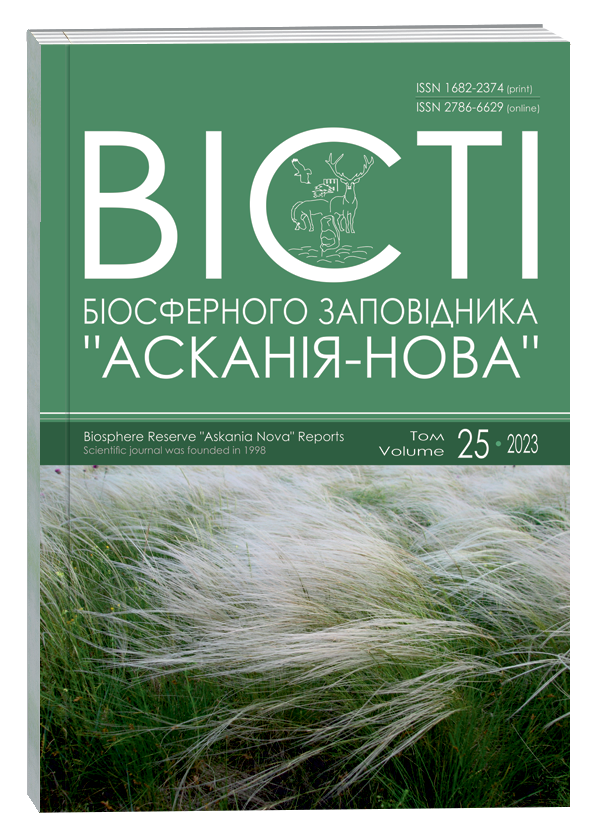PECULIARITIES OF REPRODUCTIVE DEVELOPMENT OF RARE SPECIES OF MALUS MILL. IN THE CONDITIONS OF THE NATIONAL DENDROLOGICAL PARK "SOFIYIVKA" OF NAS OF UKRAINE
DOI:
https://doi.org/10.53904/1682-2374/2023-25/16Keywords:
Яблуня, Червоний список МСОП, збереження ex situ, цвітіння, плодоношення, насінна продуктивність, життєздатність пилкових зеренAbstract
The re-search of rare and endangered species in ex situ conditions is among the measures and priority areasof activity of botanical gardens and dendrological parks in the field of plant protection, necessary for the preservation of phytodiversity. More than 25 species of Malus (most of which are intro-duced), and many cultivars, forms, and hybrids of apple trees, are cultivated and researched in the collections of the National Dendrological Park "Sofiyivka" of the National Academy of Sciences of Ukraine (NDP "Sofiyivka"), some of them are classified in the IUCN Red List as "endangered" – M. niedzwetzkyana Dieck and "near threatened" – M. trilobata (Labill. ex Poir.) C.K.Schneid. A comparative analysis of the fertility and viability of pollen grains, potential, and real seed produc-tivity, was performed to identify factors that can affect the reproductive success of plants of the mentioned species, which are characterized in the IUCN according to the trend change of their num-bers. Plants of the species M. baccata (L.) Borkh., which has been assessed in the category "least concern" and in the group "stable" according to the trend of population size change, was used as a control option for evaluating reproductive characteristics. Ecological and biological features of plants and anthropogenic aspects that can lead to a decrease in the number of populations of rare and endangered species in natural habitats are discussed. In consideration of the fact that the repro-ductive success of all flowering plants, and representatives of the Malus genus in particular, which in natural areas propagated mainly by seed reproduction, a necessary condition for the success of which is the process of cross-pollination, due to recombination, provides the necessary gene flow between individual plants for the formation of adaptive potential individuals of plant populations, we investigated the qualitative characteristics of pollen grains and seed productivity of M. niedzwetz-kyana and M. trilobata plantsʹ in comparison with the indicators of M. baccata. It ascertained that the pollen fertility of M. niedzwetzkyana, M. trilobata, and M. baccata plants ranged from 79.8 to 92.4%, instead the viability of M. niedzwetzkyana and M. trilobata pollen grains was only 5.0 and 7.3%, respectively, which is significantly lower than the viability index of M. baccata plant pollen (62.9%). In terms of the number of ovules per fruit, the difference between species was insignificant, however, when examining the number of filled seeds in a fruit, the indicator of M. baccata was 5.7±2.0, which is more than twice as much as in M. niedzwetzkyana (2.6±1.1) and almost 600 times more than in M. trilobata. The obtained results give reason to believe that M. niedzwetzkyana plants adapted to the conditions of the "Sofiyivka" Park much better than M. trilobata, which can be ex-plained by the phylogenetic relationships of M. niedzwetzkyana to the widely cultivated species M. domestica (Suckow) Borkh.
References
Кобів Ю. Й. Типи та причини раритетності на прикладі видів рослин Українських Карпат. Український ботанічний журнал. 2010. Т. 67, № 6. С. 832–844.
Конопелько А. В. Самоплідність та самофертильність декоративної яблуні (Malus Mill.). Селекційно-генетична наука і освіта (Парієві читання): матеріали Х міжнародної наукової конференції (м. Умань, 19 березня 2021 р.). Умань : УНУС, 2021а. С. 103–107.
Конопелько А. В. Морфологічна характеристика плодів та насіння представників роду Malus Mill. Journal of Native and Alien Plant Studies. Т. 1: матеріали міжнародної наукової конференції, присвяченої 225-річчю заснування Національного дендрологічного парку "Софіївка" НАН України (28–30 вересня 2021 р.). Охорона біорізноманіття та історико-культурної спадщини у ботанічних садах та дендропарках. 2021б. С. 148–155. https://doi.org/10.37555/2707-3114.1.2021.247567 Конопелько А. В. Збереження та охорона біорізноманіття роду Malus Mill. Етноботанічні традиції в агрономії, фармації та садовому дизайні: матеріали VI Міжнародної наукової конференції, присвяченої Року Незламності України (м. Умань, 5–8 липня 2023 року). Умань, 2023. С. 146–155.
Кохно М. А. Каталог дендрофлори України. Київ : Фітосоціоцентр, 2001. 72 с. Медведєв В. А., Ільєнко О. О. Дендросозофіти відділу Magnoliophyta у Державному дендрологічному парку "Тростянець" НАН України. Інтродукція рослин. 2015. Т. 68. С. 77–88. https://doi.org/10.5281/zenodo.2527205 Меженський В. М., Меженська Л. О. Червоноквіткова яблуня в колекції Національного університету біоресурсів і природокористування України. Ukrainian Journal of Forest and Wood Science. 2021. Т. 12, № 4. C. 72–82. https://doi.org/10.31548/forest2021.04.007
Опалко А. І., Конопелько А. В., Опалко О. А. Мобілізація генетичних ресурсів Malus spp. для селекційно-генетичного вдосконалення декоративних сортів яблуні. Фактори експериментальної еволюції організмів. 2016. Т. 18. С. 127–131.
Опалко А. І., Опалко О. А. Біотичне різноманіття як основа життєздатності рослинних популяцій. Journal of Native and Alien Plant Studies. 2019. Т. 15. С. 77–98.
Опалко О. А. Декоративна цінність представників роду Malus Mill. і її сезонна динаміка. Автохтонні та інтродуковані рослини України. 2006. Т. 2. С. 47–51.
Федорончук М. М. Чекліст Флори України. 4: Родина Rosaceae (Rosales, Angiosperms). Чорноморський ботанічний журнал. 2022. Т. 18, № 4. С. 305–349. https://doi.org/10.32999/ksu1990-553X/2022-18-4-1
Фізіологія рослин: практикум / О. В. Войцехівська та ін. За заг. ред. Т. В. Паршикової. Луцьк : Терен, 2010. 420 с. Alonso C., Vamosi J. C., Knight T. M., Steets J. A., & AshmanT. L. Is reproduction of endemic plant species particularly pollen limited in biodiversity hotspots. Oikos. 2010. Vol. 119, Is. 7. Р. 1192–1200. https://doi.org/10.1111/j.1600-0706.2009.18026.x Aguilar R., Quesada M., Ashworth L., Herrerias‐Diego Y., Lobo J. Genetic consequences of habitat fragmentation in plant populations: susceptible signals in plant traits and methodological approaches. Molecular ecology. 2008. Vol. 17, Is. 24. Р. 5177–5188. https://doi.org/10.1111/j.1365-294X.2008.03971.x Boyd J. N., Anderson J. T., Brzyski J., Baskauf C., Cruse‐Sanders J. Eco-evolutionary causes and consequences of rarity in plants: a meta‐analysis. New Phytologist. 2022. Vol. 235, Is. 3. P. 1272–1286. https://doi.org/10.1111/nph.18172
Bramel P. J., Volk G. M. A global strategy for the conservation and use of apple genetic resources. Global Crop Diversity Trust. Germany, 2019. 50 p. Dafni A., Firmage D. Pollen viability and longevity: practical, ecological and evolutionary implications. Pollen and pollination. 2000. Vol. 222, Is. 1/4. P. 113–132.
European Red List of Trees / M. С. Rivers et al. Cambridge, UK and Brussels, Belgium: IUCN, 2019. 60 p. https://doi.org/10.2305/IUCN.CH.2019. ERL.1.en Evans, M. E., Menges, E. S., & Gordon, D. R. Reproductive biology of three sympatric endangered plants endemic to Florida scrub. Biological Conservation. 2003. Vol. 111, Is. 2. P. 235–246. Govaerts, R., Nic Lughadha, E., Black, N., Turner, R. & Paton, A. The World Checklist of Vascular Plants, a continuously updated resource for exploring global plant diversity. Scientific Data. 2021. Vol. 8, Is. 1. 215. https://doi.org/10.1038/s41597-021-00997-6 Höfer M., Meister A. Genome Size Variation in Malus Species. Journal of Botany. 2010. Vol. 2010. P. 1–8, 480873. https://doi.org/10.1155/2010/480873 Ibanez T., Ainsworth A., Gross J., Price J. P., Webb E. L., & Hart P. J. Rarity patterns of woody plant species are associated with life form and diversification rates in Pacific islands forests. American Journal of Botany. 2021. Vol. 108, Is. 6. Р. 946–957. https://doi.org/10.1002/ajb2.1687 International Treaty on Plant Genetic Resources for Food and Agriculture: adopted by the Food and Agriculture Organization of the United Nations. Rome, Italy, 2009. 68 p.
IUCN Red List of Threatened Species. Version 2020–3. URL: https://www.iucnredlist.org (дата звернення 10.09.2023). Kempel A., Vincent H., Prati D., Fischer M. Context dependency of biotic interactions and its relation to plant rarity. Diversity and Distributions. 2020. Vol. 26, Is. 6. Р. 758–768. https://doi.org/10.1111/ ddi.13050
Kolchenko M., Nurtaza A., Pozharskiy A., Dyussembekova D., Kapytina A., Nizamdinova G., & Gritsenko D. Wild Malus niedzwetzkyana Dieck ex Koehne as a genetic resource for fire blight resistance. Horticulturae. 2023. Vol. 9, Is. 10. 1066. https://doi.org/10.3390/horticulturae9101066
Lopez-Gallego C., Morales-Morales P. A. The Red List for the endemic trees of Colombia: Effective conservation targeted for plants required in biodiversity hotspots. Plants, People, Planet. 2023. Vol. 5, Is. 4. P. 617–627. https://doi.org/10.1002/ppp3.10360 Li J. C., Liu J. Q., Gao X. F. A revision of the genus Malus Mill. (Rosaceae). European Journal of Taxonomy. 2022. Vol. 853. Р. 1–127. https://doi.org/10.5852/ejt.2022.853.2019 Mosyakin S. L., Fedoronchuk N. M. Vascular plants of Ukraine: A nomenclatural checklist. Kiev : National Academy of Sciences of Ukraine M.G. Kholodny Institute of Botany, 1999. 345 p. https://doi.org/10.13140/2.1.2985.0409 Murray B. R., Thrall P. H., Gill A. M., Nicotra A. B. How plant life-history and ecological traits relate to species rarity and commonness at varying spatial scales. Austral ecology. 2002. Vol. 27, Is. 3. Р. 291–310. Nurtaza, A., Karimova, V., Magzumova, G., Muranets, A., & Kakimzhanova, A. Effect of pH, light intensity, and fertilizers on acclimatization of endangered rooted plantlets Malus niedzwetzkyana for restoration in nature. Journal of Plant Nutrition. 2023. Vol. 46, Is. 12. P. 2850–2864. https://doi.org/10.3390/genes12010104 Nurtaza A., Magzumova G., Yessimseitova A., Karimova V., Shevtsov A., Silayev D., ... & Kakim-zhanova A. Micropropagation of the endangered species Malus niedzwetzkyana for conservation biodiversity in Kazakhstan. In Vitro Cellular & Developmental Biology. Plant. 2021. Vol. 57. P. 965–976. https://doi.org/10.1007/s11627-021-10174-4 Oostermeijer J. G. B., Luijten S. H., Petanido T., Kos M., Ellis-Adam A. C., Den Nijs J. C. M. Pollination in rare plants: is population size important. Det Norske Videnskaps-akademi. I. Matematisk Natur-videnskapelige Klasse, Skrifter, Ny Serie. 2000. Vol. 39. Р. 201–213. Qureshi S. J., Khan M. A., Arshad M., Rashid A., & Ahmad M. Pollen fertility (viability) status in Asteraceae species of Pakistan. Trakia Journal of Sciences. 2009. Vol. 7, Is. 1. Р. 12–16.
Rehder, А. Manual of Cultivated Trees and Shrubs. The Macmillan Company, New York, 1949. 996 p. Shivanna K. R. Biotic pollination: how plants achieve conflicting demands of attraction and restriction of potential pollinators. In Reproductive Biology of Plants. 2014. P. 218–267.
Tashev A., Petkova K. Fruit and seed morphological peculiarities of the critically threatened Eriolobus trilobatus (Rosaceae). Plant, fungal and habitat diversity investigation and conservation: Proceedings of IV Balkan Botanical Congress, Sofia, 20–26 June 2006. Sofia, 2009. Р 55–58. Tian Z., Song H., Wang Y., Li J., Maimaiti M., Liu Z., ... & Zhang J. Wild apples are not that wild: Conservation status and potential threats of Malus sieversii in the mountains of Central Asia biodiversity hotspot. Diversity. 2022. Vol. 14, Is. 6. 489. https://doi.org/10.3390/d14060489 Vincent, H., Bornand, C. N., Kempel, A., & Fischer, M. Rare species perform worse than widespread species under changed climate. Biological conservation. 2020. Vol. 246. 108586. https://doi.org/10.1016/j.biocon.2020.108586 Volis S. Conservation-oriented restoration and its application to Central Asia. Plant Diversity of Central Asia. 2022. Vol. 1. Р. 1–19.
Volk G. M., Chao C. T., Norelli J., Brown S. K., Fazio G., Peace C., … & Bretting P. The vulnerability of US apple (Malus) genetic resources. Genetic Resources and Crop Evolution. 2015. Vol. 62, Is. 5. Р. 765–794. https://doi.org/10.1007/s10722-014-0194-2 Wamelink G. W., Goedhart P. W., & Frissel J. Y. Why some plant species are rare. PLoS One. 2014. Vol. 9, Is. 7. e102674. https://doi.org/10.1371/journal.pone.0111293 Wilson B., Mills M., Kulikov M., Clubbe C. The future of walnut-fruit forests in Kyrgyzstan and the status of the iconic Endangered apple Malus niedzwetzkyana. Oryx. 2019. Vol. 53, Is. 3. Р. 415–423. https://doi.org/10.1017/S0030605318001230
Wilson, B. S., Jensen, W. E., Houseman, G. R., Jameson, M. L., Reichenborn, M. M., Watson, D. F., … & Kjaer, E. L. Cattle grazing in CRP grasslands during the nesting season: effects on avian abundance and diversity. The Journal of Wildlife Management. 2022. Vol. 86, Is. 2. e22188. https://doi.org/10.1002/jwmg.22188 Yan J. M., Li Y. G., Maisupova B., Zhou X. B., Zhang J., Liu H. L., … & Zhang Y. M. Effects of growth decline on twig functional traits of wild apple trees in two long-term monitoring plots in Yili Valley: Implication for their conservation. Global Ecology and Conservation. 2022. Vol. 33. e01998. https://doi.org/10.1016/j.gecco.2021.e01998 Zahreddine H. G., Barker D. J., Quigley M. F., Sleem K., & Struve D. K. Patterns of woody plant species diversity in Lebanon as affected by climatic and soil properties. Lebanese science journal. 2007. Vol. 8, Is. 2. Р. 21–44. Zhang W., Fan J., Xie Y., Peng Y., Zhou T., & Zhao M. An Illustrated Electron Microscopic Study of Crabapple Pollen. Springer Singapore, 2019. 182 р.







